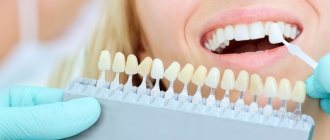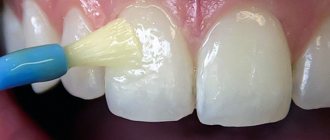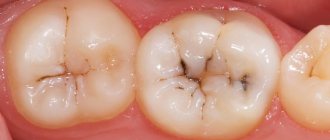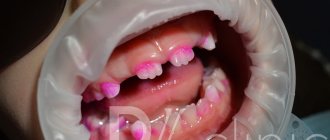Why is fluoridation of teeth necessary?
Attention! Fluoride is an essential element for dental tissue. In order to compensate for its deficiency, dentists recommend performing a fluoridation procedure. This helps strengthen dental tissue and restore normal fluoride balance. After the procedure, baby teeth become more resistant to acids and cariogenic bacteria. Timely implementation of the procedure allows you to stop the development of caries and prevent its spread to neighboring teeth. It also helps reduce enamel sensitivity.
How do fluoride medications work?
Remineralization of tooth enamel with fluoride-containing compounds often gives positive results. With its help, you can not only strengthen healthy teeth, but also stop the development of caries in its initial stage, when the enamel is not yet damaged, but a white spot has already appeared on its surface.
Fluoride-containing preparations are used in dentistry to prevent caries and restore sensitive or thinned enamel. They are effective in childhood during the growth of teeth, strengthening them at the stage of formation.
Dentists use special formulations with a high content of fluoride ions. The preparations consist of submicroscopic crystals of insoluble fluorides, which are so small in size that they are able to penetrate the pores of dental tissue. Getting into the deep layers of dental tissue, the substances contained in remineralization preparations seal microscopic tubules, preventing the penetration of bacteria. As a result, dentin and enamel become stronger. Fluorine crystals have poor solubility, so they can persist in tissues for up to two years. During this time, fluoride ions are gradually released, which helps maintain dental health.
Attention! In order to keep teeth healthy and protect them from harmful influences, dentists recommend remineralization every six months.
Remineralizing compositions, in addition to fluorine, also contain other useful substances that have an antimicrobial effect. They create a protective layer that protects not only the enamel, but also the pulp.
Fluoridation at home
In order to fluoride your teeth yourself, you need to get permission from your doctor.
He can recommend the simplest method of fluoridation - the use of fluoride paste. You should not only brush your teeth with it, but also keep the composition in your mouth for some time to strengthen the enamel.
It is also possible to carry out the procedure using mouth guards. To do this, you need to buy medications and devices recommended by your doctor: a lip retainer, applicators for applying the solution, and a fluoridating gel.
Important to know: Before the procedure, it is important to clean your teeth with any toothpaste to get rid of plaque, rinse your mouth with water, and dry your teeth with a cotton pad or hairdryer.
Next, shake the bottle with fluorogel, insert the lip retainer and, starting from the upper jaw, begin processing. It won’t be easy to do this on your own, so it’s better to ask your loved ones for help. Applying the varnish must be careful; the gel must not get on the mucous membrane. Apply it in a thin layer. After this, dry the teeth again with a cold stream of air from a hairdryer (about three minutes).
After the procedure, you should refrain from eating for three hours. The teeth are then cleaned in the standard manner. To achieve a positive result, it is recommended to repeat the procedure 10 times. It is better to do the procedures every other day.
Do children need fluoridation?
The fluoridation procedure is quite popular among patients in dental clinics. Doctors advise doing it not only for adults, but also for children. Temporary teeth are not as strong as permanent teeth. Their coating is looser and more heterogeneous, and therefore requires additional strengthening. A lack of fluoride and other microelements leads to a deterioration in the quality of enamel, the formation of microcracks, expansion of micropores and dentinal tubules, into which pathogenic bacteria then penetrate.
Fluoridation is especially effective in children during the period of teeth change, because an erupted tooth has weakly mineralized enamel, and regular fluoridation of teeth is the prevention of superficial caries in children.
Some parents believe that baby teeth do not require special care because they will fall out anyway. However, it is not. The destruction of primary teeth can lead to a number of serious complications:
- the rudiments of permanent teeth can become infected with caries;
- a damaged crown will not be able to fully perform chewing functions;
- Units damaged by caries may fall out prematurely, and this is fraught with the development of malocclusion.
What do experts recommend?
Most pediatric dentists have a positive attitude towards fluoridation of children's teeth and recommend the procedure to their young patients. The presence of different methods of fluoridation makes it possible to choose a more suitable technique for each case.
With regular fluoridation, children's teeth can be kept healthy, making it the most effective method of restoring enamel. The procedure is harmless if carried out taking into account all the characteristics of the child. In addition, children’s teeth do not require special care after the procedure.
Who is the procedure indicated for?
Dentists recommend fluoridation during the formation of baby teeth and during the period of replacing them with permanent ones. Even if the child does not have any dental problems, at the request of the parent, the doctor can perform a procedure to prevent caries. During a medical examination, the dentist may recommend that parents undergo fluoridation for their child. Typically the procedure is prescribed in the following cases:
- increased sensitivity of tooth enamel;
- thinning of the enamel or erasing of its individual sections;
- the appearance of chips and microcracks;
- initial stage of caries (white spot on the surface of the enamel);
- to strengthen teeth during filling, so that the filling lasts longer and the tooth underneath does not deteriorate;
- acute lack of fluoride in dental tissues;
- with the rapid development of caries and changes in the hormonal balance in the body, which lead to an increase in the viscosity of saliva and a decrease in its quantity (this often happens in adolescence during the period of restructuring of the body);
- use of braces.
Fluoridation should not be done even if children's teeth are apparently healthy. It will strengthen the hard tissues of the tooth and increase resistance to external influences, increasing the resistance of the enamel to the effects of acids produced by bacteria during their life.
Indications
There are several reasons why a doctor might prescribe fluoridation. First of all, this is the thinning of the enamel layer and the formation of small defects in the form of microcracks or the complete absence of the enamel layer in small areas.
When treating caries at the initial stages of its development, it allows you to successfully fight it.
This procedure is also an effective means of prevention after tooth filling, extending the service life of the filling.
And, of course, for children who live in areas where the fluoride content in water and food is reduced, and they are the source of this element, this will be an excellent preventive measure.
Naturally, parents may have a question about how much such a procedure costs. Prices vary greatly depending on the choice of method, as well as the level and quality of service. The procedure for one tooth costs from 50 rubles. And with deep fluoridation of the entire mouth, it can reach up to three thousand rubles.
Can fluoridation harm a child?
In addition to benefits, the fluoridation procedure can also cause harm.
Important! The most common negative effect of such a procedure is the oversaturation of the body with fluoride. This can lead to a disease such as fluorosis.
But usually after some time its manifestations decrease and then disappear altogether. However, before fluoridating a child’s teeth, parents should consult a doctor so as not to harm the fragile child’s body, which is susceptible to any influences. It is impossible to fluoride a child’s teeth at home without a doctor’s prescription.
At what age is the procedure performed?
The normal age for fluoridation is at least 2 years. Theoretically, it is possible to carry out the procedure at an earlier age, if there are indications for this. In this case, not deep fluoridation is carried out, but superficial one.
Age restrictions directly depend on the child’s ability to sit quietly in the dental chair for about 15–20 minutes. The older the child, the easier this process goes. The procedure is equally harmless for any age. In any case, the final decision on the advisability of fluoridation is made by the doctor, taking into account the child’s condition.
This short video describes the features of the procedure:
Fluoridation methods
There are several methods for fluoridating baby teeth. Let's look at them.
- Classic. This is the easiest way. The pre-dried enamel surface is coated with a special remineralizing composition, which is then irradiated with a special UV lamp. However, this method does not provide a long-term effect, since under the influence of saliva the remineralizing drug is quickly washed away.
- Deep. This method is more effective because the composition penetrates into the deep layers of dental tissue, resulting in the resulting effect lasting much longer.
- Express method. This method involves the use of special disposable dental trays. The dentist fills the trays with a remineralizing agent and places them on the child's teeth. Keep the composition for 7–10 minutes. In order to saturate the enamel with the necessary elements, you will need to carry out approximately ten procedures. This method is suitable for restless children who cannot sit for a long time with mouth guards.
- Kapovy. Individual dental guards are made for the child, taking into account the structural features of his jaws. These trays, together with the remineralizing composition, are used at home. However, this method is only suitable for older children.
- Electrophoresis. The dentist applies the composition to the teeth and then acts on it with electrical waves, resulting in the release of fluoride ions and their penetration into the dental tissue. This method gives a good effect, but it is not suitable for everyone.
The dentist takes impressions of the child’s dentition, and the dental technician makes individual elastic mouthguards - soft molds that are filled with a fluoride-containing preparation and placed on the teeth.
Each of these methods has its pros and cons, but most patients prefer deep fluoridation. It is equally suitable for both baby and permanent teeth. The procedure increases the strength of dental tissue by 10 times. Deep fluoridation can be performed on children starting from the age of two. It is recommended to repeat the procedure 1 to 4 times a year. How often fluoridation should be done is determined by the doctor.
What do patients ask most often?
Most often, doctors have to answer the question about the need for fluoridation of baby teeth. It can be difficult to give a definite answer. There are parents who do not see results after the procedure and doubt its necessity. There are also those for whom the procedure has become a real salvation from many problems.
Be that as it may, fluoridation is harmless. For this reason it is worth trying.
They also often ask about which procedure will be more effective - performed at home or in a clinic. Here it is definitely better to use the second option. A dentist who has performed fluoridation more than once, in conditions convenient for this, and who understands the characteristics of teeth, will definitely perform it better than the patient himself.
How is tooth remineralization performed?
The fluoridation procedure takes place in several stages. First, the dentist prepares the teeth. For good penetration of the composition into the dental tissues, it is necessary to pre-clean the teeth using a special paste that cleans the enamel of plaque and tartar. After brushing, the teeth must be thoroughly dried, since the composition is applied only to a dry surface. After drying, the doctor applies the first layer of a remineralizing drug to the enamel. It contains highly dispersed calcium fluoride and magnesium, due to which a protective coating is formed on the enamel. Next, the composition is dried. After this, the doctor covers the teeth with a second layer of the composition. This component contains copper hydroxide. Both compositions begin to interact with each other, releasing calcium fluoride ions, which easily penetrate the dental tissue. After the chemical reaction is completed, the dentist washes off the remaining composition with water.
In order to prevent caries and strengthen tooth enamel, careful oral hygiene is carried out, then the doctor applies a special fluoride-containing gel to the cleaned and dried teeth, which gradually penetrates deep into the tooth enamel.
What can replace fluoridation?
As an alternative to fluoridation, dentists may suggest silvering teeth. This procedure is often performed on children and also helps protect baby teeth from decay. How is silver plating carried out? The dentist applies a special preparation containing silver to the enamel surface. As a result, a thin protective film is formed on its surface.
Important! Silvering helps stop the development of caries, which has already begun, until the child grows up and is ready for treatment.
The silvering procedure takes little time and does not cause discomfort or any pain. However, many refuse it due to the fact that silver oxidizes from saliva and air, and the enamel becomes very dark over time.
Silvering of teeth is a treatment with a special composition based on silver nitrate; this technique is used to prevent the development of caries in primary teeth in children under three years of age.









